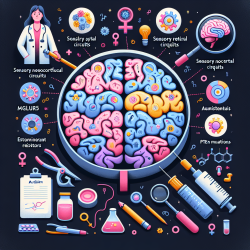The recent research titled "Female-specific dysfunction of sensory neocortical circuits in a mouse model of autism mediated by mGluR5 and estrogen receptor" sheds light on the intricate mechanisms by which sex-specific factors influence autism spectrum disorder (ASD). This study reveals how the deletion of the autism risk gene PTEN in neocortical pyramidal neurons leads to cortical circuit hyperexcitability specifically in female mice. This hyperexcitability is driven by metabotropic glutamate receptor 5 (mGluR5) and estrogen receptor (ER) signaling pathways.
Key Findings and Their Implications
The study highlights several critical findings that practitioners should consider:
- Circuit Hyperexcitability: The research demonstrates that female mice with PTEN deletion exhibit prolonged spontaneous persistent activity states, indicating robust cortical circuit hyperexcitability. This is mediated by mGluR5 and ER signaling pathways.
- Sex-Specific Differences: The findings underscore the importance of considering sex-specific differences in ASD. Female mice showed deficits in sensory processing and social behaviors, which were not observed in males.
- Potential Therapeutic Targets: The study suggests that targeting mGluR5 and ER signaling pathways could offer therapeutic benefits for females with ASD. Genetic reduction of ER rescued enhanced circuit excitability and other deficits selectively in female mice.
Practical Applications for Practitioners
This research provides valuable insights for practitioners working with individuals with ASD:
- Differential Diagnosis: Understanding sex-specific manifestations of ASD can aid in more accurate diagnosis and personalized treatment plans.
- Treatment Strategies: Consider exploring therapies targeting mGluR5 and ER pathways, especially for female patients exhibiting sensory processing deficits or social behavior challenges.
- Further Research: Encourage further research into sex-specific mechanisms in ASD to develop more effective interventions tailored to individual needs.
This study opens new avenues for understanding the complex interplay between genetic factors and sex-specific brain functions in ASD. By integrating these insights into practice, clinicians can enhance their ability to provide targeted support to individuals with ASD.










